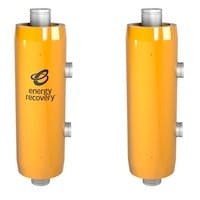Energy Recovery Inc. announced that its technology will be used in the Carlsbad Desalination Project to help reach its carbon neutral goals while significantly reducing overall energy costs. IDE, technology provider and future operator of the plant, awarded Energy Recovery a contract for its innovative energy recovery device (ERD) technology to the project, which will be the largest desalination plant in the western hemisphere. As part of the agreement, Energy Recovery will provide 144 of its PX Pressure Exchanger Q300 units to the seawater reverse-osmosis plant, aiding the estimated production output of 189,250 cu meters of desalinated water per day (equivalent to 50 million gal per day). The units are expected to ship by the end of the year.
By choosing the PX technology, the vanguard project for California's first large-scale plant will save an estimated 116 million kWh of energy per year, the equivalent of $12 million. This energy savings will also reduce CO2 emissions by 41,0002 metric tons per year—roughly the annual greenhouse gas emissions from 8,542 passenger vehicles.
Energy Recovery's PX Pressure Exchanger devices work by capturing hydraulic energy from the high-pressure reject stream of SWRO processes and transfers this energy to low-pressure feed water with an efficiency of more than 98%. Because the PX device itself consumes no electrical power and recycles otherwise lost energy in the form of pressure, the overall energy consumption of the process is drastically reduced.
When the Carlsbad plant comes online in 2016, it will bring the largest, most technologically advanced and energy-efficient desalination plant in the western hemisphere to San Diego County. In California and across the U.S., long-standing sources for fresh water are either diminishing because of droughts or becoming unsustainable given population and agricultural growth. The Carlsbad Desalination Project will provide the region with a locally controlled, drought-proof supply of high-quality water that meets or exceeds all state and federal drinking water standards.
Semi-arid San Diego County has very limited local water resources; the County Water Authority's long-term strategy to enhance the reliability of the region's water supply includes diversifying its water supply sources. The Carlsbad Desalination Project is a crucial element of this plan and will provide enough high-quality drinking water to serve up to 112,000 households.
Along with the other project partners, Energy Recovery is working to demonstrate that desalination is a viable solution to growing water demand. The Carlsbad desalination plant is signaling a trend for upcoming projects in the U.S. According to Global Water Intelligence, there are currently more than 12 desalination projects in various stages of planning in California, and more that 40 medium and large projects on the drawing board across the U.S.
"The Carlsbad project has moved the needle for the desalination industry in the U.S.," said Tom Rooney, CEO at Energy Recovery. "We're excited to bring our experience and technologies to help this project and future U.S. desalination plants maximize their energy savings just as we have helped quench demand in regions and countries lacking fresh water like Australia, China and the Middle East North Africa."
Source: Energy Recovery Inc.


